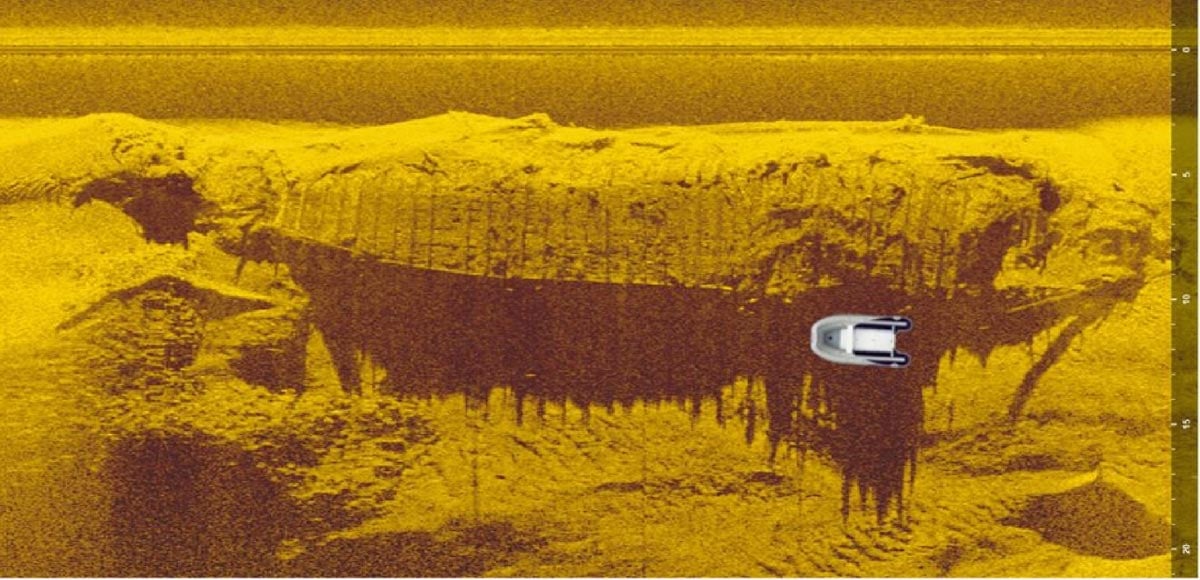Divers Detect Titanic 700-Year-Old Shipwreck in Vistula River
A centuries old shipwreck described as “huge and rare” has been discovered by underwater archaeologists in the Vistula River north of Warsaw in Poland.
Measuring a whopping 37-meters-long (121 foot) and 6-meters-wide (20 foot), this historic ship was discovered by a team of underwater archaeologists exploring in the Vistula River north of Warsaw in Poland, and according to a report in Science in Poland the boat used to carry up to “100 tons of goods.”
The successful research project was funded by the Ministry of Culture and Scientific Heritage with support of the Institute of Archaeology of the University of Warsaw, and the “massive” newly discovered boat is thought to have been a transport vessel operating between the 14th and 18th centuries. Dr. Artur Brzóska is an underwater archaeologist and head of the research project from the Association of Archaeologists Jutra, and he believes it probably “transported grain to Gdańsk.”
Piercing The Tide Line
Poor visibility and strong water currents were among the negative environmental challenges that stopped the divers recovering any artifacts from the sunken ship. But Brzóska pointed out that wrecks such as these are “very rare” and until this discovery only two wrecks were previously known in this part of the river: a 16th century and 19th century ship. This new boat is a so-called “berlinka,” which was an elongated, shallow, barge-type craft designed for canal transportation, and while an article like this makes it all sound so simple, finding the rare wreck took what amounted to a major scientific operation.

Sonar image of the centuries-old boat discovered in the Vistula River in Poland. (A. Szerszeń / Podwodne wraki Warszawy)
Before the researchers discovered the “huge” boat they mounted hi-tech sonar equipment around a motorboat and selected a series of test sites with a view to diving at any interesting findings on the scans. The system was tested on the Vistula River near Warsaw`s Old Town and the project required sailing around 400 kilometers (250 miles) along parallel survey lines scanning a 13-kilometer-long (8 mile) stretch of the river, covering nearly 500 hectares in all.
The scientists first found the decomposing remains of a World War II bridge sunk near Łomianki Dolne, and the geometry of its steel structure informed Brzóska’s team that it had been built by “German sappers.” They also found parts of another ship driven into the bottom of the river and a fragment from the vessel pulled to the surface led Brzóska to the conclusion that it too might have been a cargo boat, similar to the huge one they discovered.
- Family Discovers a Collection of Rare Bronze Age Artifacts in Poland
- Timeless Stories Built on Grains of Salt: Examining the Masterpieces within a Polish Salt Mine
- Polish Museum Claims to Have Located the Elusive Amber Room that Was Stolen by Nazis

Researchers about to dive at the site of the shipwreck on the Vistula River in Poland. (Podwodne wraki Warszawy)
A Local River Connected To Great Nations
While the wrecks being discovered today are from the last 600 years, beneath them, deep in the silts of the riverbed, are the rotting remains of much more ancient vessels, as the Vistula basin was occupied in the 1st millennium BC by Iron Age Lusatian and Przeworsk cultures. 1st century Roman authors called the region “Magna Germania” and in the 2nd century AD Ptolemy described the Vistula River as the border between Germania and Sarmatia. According to an article on Suwalszczyzna the Vistula River used to be connected to the Dnieper River, and thence to the Black Sea via the Augustów Canal, one of the most ancient trade routes, the Amber Road, which connected Northern Europe with Asia, Greece, Egypt, and elsewhere.
Encyclopedia Britannica says that for hundreds of years the river was one of the main trade routes of ancient Poland and the Vistula estuary was settled by Slavs in the 7th and 8th century. Moving through the canals of time, the magnificent if not ostentatious castles and fortresses that line the riverbanks all stand testimony to the wealth accumulated through the trade of salt, timber and stone between the 10th and 13th centuries.

Shot of the Vistula River in Poland where the shipwreck was found. (itsmejust / Adobe stock)
In the 16th century most of the grain exported from Poland left from the city of Gdańsk, and being located at the end of the Vistula, with its Baltic seaport trade connections, it became the wealthiest, most highly developed and connected of the Polish cities. It was this thriving Polish city that Dr. Artur Brzóska believes the newly discovered massive barge transported grain to, but the team are awaiting further results before drawing this conclusion.
Top image: A sonar image of the wreck in the Vistula River and the dingy the archaeologists used to search for it, showing the relative size of the ship. Source: Podwodne wraki Warszawy
By Ashley Cowie



















